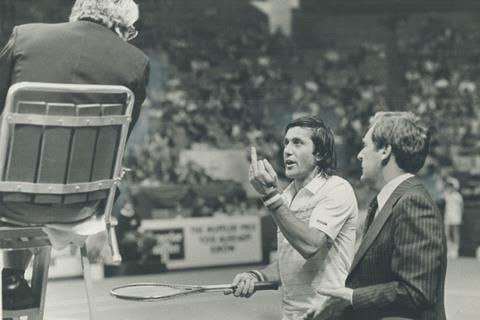Colourful documentary profiles the impact of Romanian player Ilie ‘Nasty’ Nastase on the world of tennis and beyond

Dirs: Tudor Giurgiu, Cristian Pascariu, Tudor D Posecu. Romania. 2024. 104mins
In 1972, Romanian tennis player Ilie Nastase was at the top of his game. He had won the US open, made it to the Wimbledon final and was dominating the Davis Cup — the final of which would be played on home turf in Bucharest. He had also signed with then-fledgling sports brand Nike. Handsome, charismatic and with an almost preternatural talent with a racket (and a temper to match), he was becoming something of a rock star rebel of the sport. This engaging, jam-packed documentary profiles the rise of the player they called Nasty, using the pivotal year of 1972 as a jumping off-point.
Nastase’s relationship with his home country proves the film’s most interesting thread
After releasing in Romania on April 19, where it topped the box office, Nasty plays as a Cannes Special Screening the day before it streams on HBO Max (which co-produces) across Europe. The film, co-directed by Romanian filmmaking trio Tudor Giurgiu (also founder of the Transylvania Film Festival), Cristian Pascariu and Tudor D. Popescu, should appeal to fans of the sport, and of similarly energetic tennis films like McEnroe, Boom! Boom! The World Vs Boris Becker, Borg Vs McEnroe and Battle Of The Sexes. That Luca Guadagnino’s recent Challengers has made tennis sexy may also help it find a wider audience.
Nastase is a compelling, complex character. Born in Romania in 1946, he picked up a racket at a young age and, in his early 20s, teamed up with ice hockey star turned tennis player Ion Tiriac. The two became an unbeatable doubles team, leading Nastase to singles fixtures. In Stockholm, in 1969, Nastase beat top players including the American Stan Smith, and the world began to take notice.
Nastase’s talent was always undeniable. Archive footage, whether in colour or black-and-white and set to a propulsive score by Marius Leftărache, showcases his balletic athleticism. He could return a ball from almost impossible angles. Yet it was his personality that made him famous beyond the confines of the sport. Cheeky and quick-tempered, he enjoyed playing up for the crowd, shouting, swearing and being generally ungentlemanly in a way that tennis — up until then, a game considered somewhat elitist — was not ready for.
There is plenty of footage showing Nastase in full aggressive flow: the crowd clearly loved it and people flocked to see him perform. Many in the sport credit Nastase for opening tennis up to the masses, helping to turn it into the professional sport with big-money prizes it became in the mid-1970s. Yet it wasn’t so much fun for his opponents. We see him losing his cool during matches with, among others, Arthur Ashe in 1975 (Ashe eventually walked off the court in protest), and a young John McEnroe in 1979 — McEnroe, perhaps the most famous ‘bad boy’ of the sport, recalls watching Nastase wind himself up to the point where he was defaulted. Interestingly, an archive interview with Derek Hardwick, then president of the International Tennis Federation, highlights how Nastase’s behaviour led directly to the tightened code of conduct by which the game operates today.
The film does not push too hard into the darker elements of Nasty’s character, which seem to have endured into older age. It does include footage of his 2017 racist remarks about Serena Williams’ unborn child, for which Nastase, then Romania’s team captain, received a four-year ban from the sport. (Although it swerves his verbal abuse of female officials, players and journalists at the Fed cup that same year.) Nastase, now 77 and occasionally speaking to camera, is not probed about these more recent outbursts, and will only go so far as to describe himself as ‘passionate’.
An impressive roster of talking heads – including tennis greats like Billie Jean King, McEnroe, Becker, Rafael Nadal and Jimmy Connors together with sports journalists and a raft of women including model Cheryl Tiegs – acknowledge Nastase’s rebellious streak, but all describe him as someone with a heart of gold. (Notably, none of Nastase’s five wives are featured). While African American Ashe, who died in 1993, cannot speak to his feelings about being called ‘Negroni’ by Nastase, his contemporaries point to well-meaning ‘locker room banter.’ Nastase himself was nicknamed ‘Commie’.
Indeed, Nastase’s relationship with his home country proves the film’s most interesting thread; not least because his rise to fame coincided with a period in which Romania was trying to break out from the influence of the Soviet Union. As noted by Jonathan B Rickert, then a junior diplomat to the US embassy, most Americans could not have pointed to Romania on a map before Nastase emerged from behind the Iron Curtain. Nastase speaks of the intense pressure he felt when he bought the Davis Cup back to Bucharest in 1972 (the home players subsequently lost to the US team). And in 1989, when communist leader Nicolae Ceausescu was toppled, Nastase, who had by then retired as a player, became a key spokesperson for the revolution.
Production companies: Libra Films
International sales: Goodfellas
Producers: Cosmin Hodor, Tudor Giurgiu
Cinematography: Alex Brenda
Editing: Tudor D Popescu
Music: Marius Leftărache

















![2026_FORUM_LETTER TO ALVIN_Main still[59]](https://d1nslcd7m2225b.cloudfront.net/Pictures/100x67/6/9/5/1469695_2026_forum_lettertoalvin_mainstill59_712728_crop.jpeg)




